I have this circuit I built long ago to amplify 2mV signal from speaker and phase shift it by 2.5V.
Now the question is, what does C2, C4, R5, and R6 exactly do?

I have this circuit I built long ago to amplify 2mV signal from speaker and phase shift it by 2.5V.
Now the question is, what does C2, C4, R5, and R6 exactly do?

R5 and R6 set the gain of the circuit.
C4 technically changes the frequency response, giving it a LOWER gain at higher frequencies, but the value of the cap implies that it's just there to add some stability to the circuit and won't effect the audio frequency response too much.
C2 also changes the frequency response of the circuit-- reducing the gain at low frequencies. Basically, cutting off the bass frequencies. I am assuming (I have not calculated) that this will cut off frequencies below about 200 or 300 Hz.
Technically, C2 is doing the same function (High Pass Filtering) as C1+R2+R3. Odds are high that you could remove C2 (short it out) and have a circuit that works just fine.
UPDATE: I should also mention that this circuit is missing a DC blocking cap on the output. This is normally done, especially when the opamp is ran off of a single supply rail.
C4 reduces closed-loop gain at high frequencies. It is a form of dominant pole compensation to fend off the risk of amplifier instability. It shouldn't be necessary with internally compensated op-amps, but it's good to leave a spot on the circuit board for it.
As for C2, primarily it is needed for proper biasing. If R6 were connected directly to ground, the amplifier would have a large DC offset at the output. The feedback cannot be referenced to ground because the amplifier is based around the 2.5V operating point. C2 provides an "AC ground" for the feedback loop, without coupling it to the 0V DC ground. The presence of C2 has the side effect that the amplifier has only unity gain at DC: bass is rolled off, in other words.
Rheostat R6 controls the gain, which, ignoring frequency effects, is basically \$1 + R_5/R_6\$. The smaller the resistance that is dialed in on R6, the bigger the gain. The particular wiring of a potentiometer to serve as a rheostat shown in the schematic is a good method, because if the wiper of the potentiometer happens to make an intermittent contact, the resistance of the part will not go above that of its resistive element. The circuit has a minimum gain, when R6 is maximum, with no upper bound on the gain: when R6 is turned toward zero, the gain increases rapidly toward a large value. The circuit designer wanted the user to be able to get large amounts of gain from a single op-amp stage.
By the way, since C2 blocks DC, it also ensures that R6 operates quietly. When significant DC flows through potentiometers, they can create a scratchy sound when operated.
This circuit has a bit of a flaw: the designer neglected to capacitively bypass the voltage divider formed by R2 and R3. That is to say, R3 should be paralleled with a capacitor to reduce power supply ripple, which will appear as a signal at the node between R2 and R3. Thus the design relies on VCC being well regulated.

Hope I haven't missed anything. Well possibly I did - David Kessner reminded me that answers sometimes have to go the extra mile because they may be read by a person who has R6 (10k pot e.g.) tied to a midrail point and therefore doesn't need C2 to make the circuit function correctly. Under these circumstances C1 becomes the dominant component to block low frequencies and as the values of components currently stand C1, R2 and R3 form a high pass filter of about 7Hz. The 7Hz previously said 40Hz which is wrong and I can't explain such attrocious numeracy!!